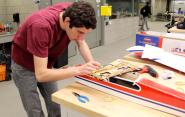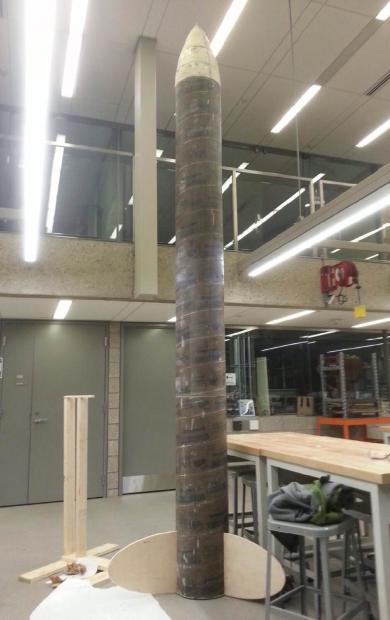A Time to Rest, A Time to Innovate

As the 2014 Spring Break comes to a close, students are returning to campus rested and ready for the final stretch of the academic year. But for many Yalies, a little “R ’n R” goes far beyond sunbathing at the beach. Instead, these students have spent spring break pursuing their passions, preparing for national competitions, and doing their part to save the world.
A Busy Break
Ellen Su is a Design Fellow at the Center for Engineering Innovation and Design (CEID). Throughout the day, she works a little with every project that comes her way, encouraging safety and innovative thinking for every individual or group that hopes to fully utilize the CEID’s resources. “Seemingly everybody took the opportunity to jump in here, working really intensely on their projects when they thought no one else would be around,” she says. “Which means the CEID was packed pretty much all day, every day, with students using the shop, using the laser cutter. It’s been intense.”
But while the students Su has helped over the break are united in their passion for creating and engineering, their interests are diverse. “The first week was amazing,” says Su. “On one table, we had a modified Segway that’s being engineered to drive by itself. The second table, we had a team building a Mars rover. The third table, we had a fifteen foot rocket—you couldn’t miss the rocket. It’s a fifteen foot cardboard tube that was over a foot in diameter, just massive. And they were building the nosecone, the inside struts, the payload deployment. And on either side of these big projects, people were working on their senior projects, on drones, on medical devices, surgical tools—people working on their own projects all over the place. Everyone’s been here a lot.”
Many of the largest projects are being prepared for spring competitions. The Yale Rover Association, for example, is entering the University Rover Challenge, a yearly competition to design a rover that could accompany astronauts on future Mars exploration missions. Likewise, the five sophomores responsible for the autonomous Segway are preparing for the Intelligent Ground Vehicle Competition (IGVC), where their vehicle will be tested on its ability to navigate through a series of GPS waypoints on a grassy field, all while staying within painted white lines. “It’s an autonomous vehicle. It has cameras on it, it can navigate obstacles. The IGVC people have been here the entire break, basically working here every day,” says Su.
Not Your Average Spring Break Flight
But not all team projects are measured by competition results. The giant rocket, which belongs to the Yale Undergraduate Aerospace Association, is one component of a rocket-launched Unmanned Aerial Vehicle (UAV)—an autonomous airplane that fits inside the rocket by folding its wings back over the plane’s body. When the rocket is at its peak height, the plane is let loose and flies back to the ground. Many of the team’s other projects, including a quadcopter and a “lighter than air” blimp, have been designed with competitions in mind, but YUAA chose the UAV project simply to get hands-on engineering experience. That, and because the project’s challenges are so fun to address.
“The rocket is made out of fourteen-inch diameter sonotube and has wooden fins which were cut on the laser cutter in the CEID and designed by YUAA members,” says YUAA team member Genevieve Fowler. “After deployment, we hope the UAV will be able to autonomously navigate to waypoints and to land, all while streaming information and video to observers on the ground. [In our test flight last fall,] it was discovered that the plane could go from an almost standstill to flying without dropping more than five feet, which is a very promising result for the future.”
A Spring Break with Purpose
Project Bright, a student group that aims to increase the amount of solar energy generated at Yale, also spent time over break gathering around tables in the CEID, but first they had to spend time unpacking a few boxes. “The Geology building has been generous enough to let us do a test installation of five different kinds of solar panels on their roof,” says team member Sam Kaufman-Martin. “We’re going to test how each kind of panel performs in the New Haven climate and then give our assessment to Yale administration.” The panels arrived in time for Project Bright team members to begin analyzing them over the break. “Right now we’re taking our solar panels and looking at how they’re wired and how we’re going to attach them to the roof. In the next couple of weeks after spring break, we should be putting them up.”
However, an engineering spring break can be globally-minded without taking up more space than, say, about 50,000 bees.
This past fall, Yale senior Glen Meyerowitz and sophomore Alison Fritz co-founded Yale Bee Space, an organization dedicated to educating Yale students about beekeeping. In a partnership with the West Campus Urban Farm, Bee Space is researching how man-made beehives—an innovation first developed at Yale in 1852—can be improved. “We’re trying to learn more about what’s going on inside the hives, hopefully so we can prevent what causes bee colony collapses across the country,” says Meyerowitz.
The first step in that process is gathering data, and to that end, Meyerowitz spent time over the past two weeks installing Bee Space’s first batch of sensors to measure the temperature, humidity, weight, and audio levels inside of a beehive. “With the first round of sensors,” he says, “everything was working very well, and we could remotely see everything that we’re looking for. Unfortunately, the battery died after a short amount of time, but that was expected.”
But with this initial success, Bee Space, like all the groups who’ve been working at the CEID, is coming back from the break with a very different “battery” recharged and ready to keep innovating.


